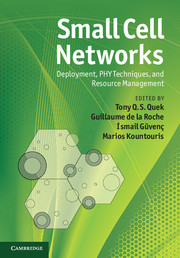Book contents
- Frontmatter
- Contents
- List of contributors
- Foreword by David Chambers
- Acknowledgments
- Acronyms
- 1 Small cell networks overview
- 2 Fundamentals of access control in femtocells
- 3 Coverage analysis using the Poisson point process model
- 4 Interference modeling for cognitive femtocells
- 5 Multiple antenna techniques in small cell networks
- 6 Physical layer techniques for cognitive femtocells
- 7 Femtocell coverage optimization
- 8 Random matrix methods for cooperation in small cell networks
- 9 Mobility in small cell networks
- 10 Cognitive radio resource management in autonomous femtocell networks
- 11 Decentralized reinforcement learning techniques for interference management in heterogeneous networks
- 12 Resource allocation optimization in heterogeneous wireless networks
- 13 New strategies for femto-macro cellular interference control
- 14 Femtocell interference control in standardization
- 15 Spectrum assignment and fairness in femtocell networks
- 16 Self-organization and interference avoidance for LTE femtocells
- Index
- References
16 - Self-organization and interference avoidance for LTE femtocells
Published online by Cambridge University Press: 05 May 2013
- Frontmatter
- Contents
- List of contributors
- Foreword by David Chambers
- Acknowledgments
- Acronyms
- 1 Small cell networks overview
- 2 Fundamentals of access control in femtocells
- 3 Coverage analysis using the Poisson point process model
- 4 Interference modeling for cognitive femtocells
- 5 Multiple antenna techniques in small cell networks
- 6 Physical layer techniques for cognitive femtocells
- 7 Femtocell coverage optimization
- 8 Random matrix methods for cooperation in small cell networks
- 9 Mobility in small cell networks
- 10 Cognitive radio resource management in autonomous femtocell networks
- 11 Decentralized reinforcement learning techniques for interference management in heterogeneous networks
- 12 Resource allocation optimization in heterogeneous wireless networks
- 13 New strategies for femto-macro cellular interference control
- 14 Femtocell interference control in standardization
- 15 Spectrum assignment and fairness in femtocell networks
- 16 Self-organization and interference avoidance for LTE femtocells
- Index
- References
Summary
Introduction
Femtocell access points (FAPs) are foreseen to play a key role in the development and deployment of future orthogonal frequency division multiple access (OFDMA)-based cellular networks, e.g., Long Term Evolution (LTE) [1] and Wireless Interoperability for Microwave Access (WiMAX) [2], since they may deliver improved indoor coverage and network capacity [3]. Femtocell access points are low-cost, low-power, user-deployed small base stations (BSs), which provide wireless coverage of a cellular standard, and are connected to the network operator via a broadband connection, e.g., digital subscriber line (DSL), fiber optics, etc. Femtocells, as explained in the introductory chapter, offer a large number of advantages to future cellular networks. They may enhance indoor coverage, deliver both high data rates and new applications to users, and offload traffic from existing macrocell networks [4]. However, since FAPs are expected to be deployed in large numbers and because they may be installed by users in an uncoordinated manner, including self-organizing network (SON) capabilities in FAPs may be a key aspect for their successful operation of these devices [5].
A SON, defined as a network that requires minimal human involvement due to the automatic and/or autonomous nature of its functioning, integrates the processes of planning, configuration, optimization, and healing in a set of in-built automatic/autonomous functionalities. By using SON capabilities, operator intervention for network operation and maintenance can be reduced, thus minimizing deployment and operational costs of future cellular networks, which are major concerns of current mobile operators.
- Type
- Chapter
- Information
- Small Cell NetworksDeployment, PHY Techniques, and Resource Management, pp. 383 - 411Publisher: Cambridge University PressPrint publication year: 2013
References
- 1
- Cited by



